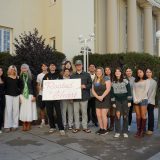
Margaret Sosa Precision and Papel Picado
November 4, 2016
The Clear-cut panel event on the art of papercuts, and the exhibition, Geometric Aljamía, focuses on the art of papercutting from diverse cultures around the world. One of these international techniques is known as, “papel picado,” a Mexican style of papercutting that has roots in the country’s ancient history. In pre-Hispanic Mexico, the Aztec people would use tree bark to make paper that would be hung to decorate temples and other gathering places for religious festivals and rituals. Even after the Spanish conquest of the Aztecs in the 1500s, however, this tradition was maintained when tissue paper, or papel de china, was introduced from Chinese imports in the 1700s. Because of the tissue paper’s thin, pliable qualities, artists found the new material relatively easy to fold and cut many pieces at once into decorative, elaborate designs, and papel picado was quickly adapted for use during Christian festivals in Mexico.
Today, papel picado can be found adorning streets and buildings during weddings, Easter, Christmas, and, most notable, the Day of the Dead. Most papel picado is machine cut today in order to mass-produce these detailed decorations, but only a few artists still continue to cut sheets by hand using a variety of chisels and knives to complete up to 50 sheets at a time. One of these remaining artists is papercutter Margaret Sosa.
Sosa is a graduate of California State University, Los Angeles, where she received a Bachelor of Arts degree in studio art. She has studied papel picado for over three decades, studying as an apprentice under master papercutter Olga Ponce Furginson, traveling with her to Mexico and becoming fully immersed in the artistry of papel picado directly from Mexican papercutters. Sosa teaches papel picado
to aspiring artists of all ages and has had her own papel picado featured in exhibits both locally and around the world.
The geometric patterns and symmetry that are present in all of Sosa’s designs of her individual papel picado sheets make an otherwise very limited, two-dimensional medium, appear layered and three-dimensional, as Sosa tends to carve detailed figures into the center of each sheet. She commonly depicts festive skeletons or painted skulls in her cutting, which are common images associated with the Day of the Dead. While skeletons are typically associated with death, gloom, and foreboding, the bright colors of paper Sosa uses is indicative of the festive, celebratory nature of the Day of the Dead in Mexican culture. Sosa’s meticulous attention to detail and drive to achieve authenticity in papel picado by studying beneath traditional artists not only informs her own art, but also contributes to the papel picado art form as a whole, keeping an ancient, hand-cut tradition alive in modern times.
Margaret Sosa will be speaking at Clear-cut: The Point of Papercuts, a panel discussion on the art of papercuts at Chapman University. The panel will take place on Monday, November 7th, from 6:00 – 7:30pm in the Bush Conference Center located in Beckman Hall, Room 404. The panel is free and open to all; no RSVP is required. Participants of the panel include Jorge Benitez, Reni Gower, Bovey Lee, and Chris Natrop.
Please contact Esther Shin at artcollections@chapman.edu or 714-628-2832 for more information.
We are grateful to the Escalette Permanent Art Collection Endowment for generously supporting this program.



